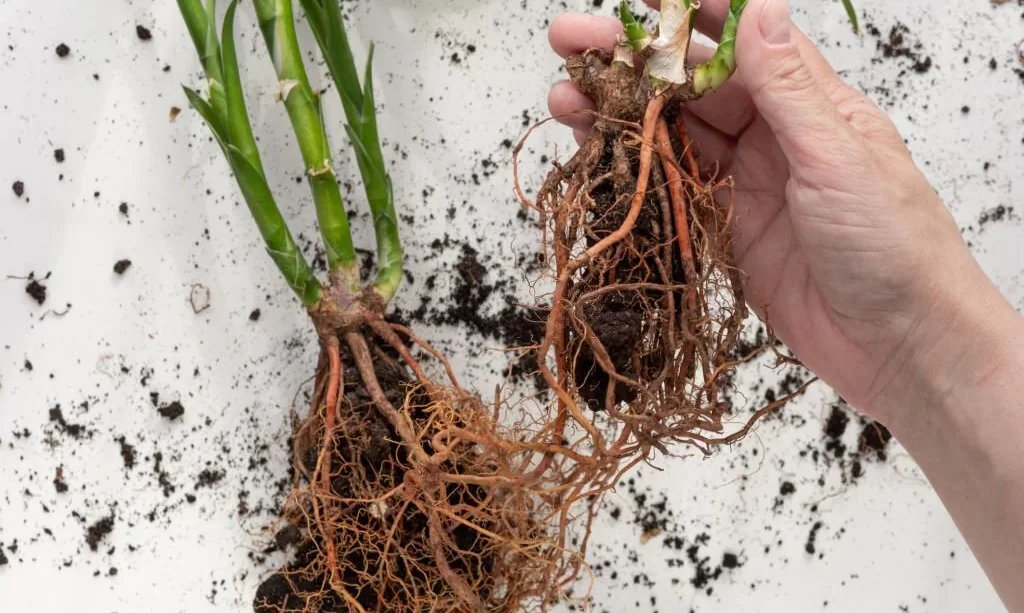Lucky bamboo, with its graceful appearance and reputation for bringing good fortune, has become a beloved addition to many homes. Whether you’re a seasoned plant enthusiast or just starting your indoor gardening journey, knowing how to repot lucky bamboo is a valuable skill. In this easy-to-follow guide, we’ll walk you through the steps to ensure your lucky bamboo thrives in its new home. Repotting not only promotes its health but also keeps it looking lush and vibrant. So, let’s dive in and learn the art of repotting this charming and auspicious plant.
- ½ gallon / 2 dry quarts of Bamboo or Bonsai Plant Potting Soil Mix. Soil is packed in a resealable clear poly zip bag. Soil can be stored in the bag as long as its kept dry.
- Custom hand blended soil prepared in Maryland, USA from Baby Violets.
- Potting Soil Mix can be used for lucky bamboo, bamboo shoots, rhizome bamboo, cherry bonsai, fig bonsai and desert rose bonsai plants.
- One bag of soil can fill, 22 (2″ pots) or 11 (3″ pots) or 4.5 (4″ pots). Please note, this is an estimate and the amount may vary slightly, based upon plant stem and root size.
- Soil contains 50% peat moss & 50% perlite. There are no extra additives to this potting mix and no fertilizers. The perlite (super coarse), provides extra drainage and is chemically inert and sterile. This is a lightweight, airy soil mix. Not dense, compressed or compacted.
Materials Needed
To get started with repotting your lucky bamboo, you won’t need an extensive list of supplies. Here’s what you’ll require:
- New Pot: Select a pot that is slightly larger than the current one. Make sure it has drainage holes to prevent waterlogged soil.
- Fresh Potting Soil: Acquire a high-quality potting mix suitable for indoor plants. It should provide good aeration and drainage.
- Pruners or Scissors: You’ll need these for trimming any yellow or damaged leaves and for pruning the roots if necessary.
- Small Rocks or Pebbles: These are handy for creating a drainage layer at the bottom of the new pot to help excess water escape.
- Liquid Fertilizer: A few drops of liquid fertilizer can give your repotted lucky bamboo a nutrient boost.
- Clean Water: Ensure you have clean, room-temperature water for watering your plant after repotting.
With these basic materials at your disposal, you’re all set to embark on the journey of repotting your lucky bamboo and ensuring its continued vitality.
Choosing the Right Pot
Selecting the right pot is crucial for the well-being of your lucky bamboo. Opt for a pot that is slightly larger than the current one but not too big. A pot that’s about an inch wider in diameter should suffice. Look for a pot with drainage holes at the bottom to allow excess water to escape. Transparent containers can be visually appealing, as they allow you to admire the roots, but any suitable pot with good drainage will do. Keep in mind that a larger pot allows room for growth without overwhelming the plant, ensuring it has adequate space to thrive.
Preparing the New Pot
Before you repot your lucky bamboo, it’s essential to prepare the new pot properly. Start by cleaning and sanitizing it to prevent any potential diseases from affecting your plant. Once clean, add a layer of small rocks or pebbles at the bottom of the pot. This layer promotes proper drainage and helps prevent water from accumulating at the roots, which can lead to rot. Proper drainage is essential for the overall health of your lucky bamboo. By taking these steps, you’re creating an environment where your plant can flourish.
Removing the Lucky Bamboo
Carefully removing your lucky bamboo from its current pot is the next step. Gently hold the plant’s stems near the base, taking care not to damage the leaves or stems. Turn the pot upside down and tap it lightly to release the plant. If the bamboo doesn’t come out easily, you can gently slide a knife or a flat tool around the inner edge of the pot to loosen it. Once the plant is free, inspect the roots. If they appear crowded or overgrown, this is a good time to consider root pruning for a healthier plant. With a gentle touch, you can ensure your lucky bamboo transitions smoothly to its new home.
Trimming and Pruning
Now that you’ve safely removed your lucky bamboo from its old pot, it’s time to give it a little makeover. Start by examining the plant for any yellow or unhealthy leaves. Use pruners or scissors to carefully trim these leaves away. This not only improves the plant’s appearance but also redirects energy towards healthier growth. If you notice the roots are densely packed or circling the root ball, consider root pruning. Trim the roots by cutting away about a third of them to encourage new root growth and prevent root-bound issues. Trimming and pruning are essential steps to promote your lucky bamboo’s vitality and ensure it flourishes in its new environment.
Adding Fresh Soil
The next step in repotting your lucky bamboo is to provide it with fresh, nutrient-rich soil. Select a high-quality potting mix suitable for indoor plants. Fill the new pot about a third of the way with this fresh soil. If you want to give your bamboo an extra boost, mix a few drops of liquid fertilizer into the soil. This will provide essential nutrients for its growth. Gently pat down the soil to remove any air pockets and create a stable foundation for your plant. Adding fresh soil gives your lucky bamboo the nourishment it needs to thrive in its new home.
Replanting the Bamboo
With your fresh soil in place, it’s time to reintroduce your lucky bamboo to its new pot. Carefully position the plant in the center of the pot, ensuring it sits at the same depth as it was in the old pot. Hold the bamboo steady as you gently add more soil around the plant. Press the soil down lightly to secure the bamboo in its new home. Be mindful not to bury the bamboo too deep or too shallow. The goal is to provide a stable and supportive environment for your plant’s roots to grow and flourish. With the bamboo securely replanted, you’re well on your way to having a thriving and beautiful indoor plant.
Watering and Care
Proper watering and care are essential to ensure your repotted lucky bamboo thrives. After repotting, give your plant a thorough but gentle watering. Use room-temperature water and pour it slowly into the new pot until you see water start to drain from the bottom. Be cautious not to overwater, as lucky bamboo is susceptible to root rot. Allow the top inch or so of the soil to dry out before watering again. Keep your lucky bamboo in a location with indirect sunlight, as direct sunlight can scorch its leaves.
To care for your lucky bamboo, periodically wipe the leaves with a damp cloth to remove dust and keep them looking vibrant. Keep an eye out for any signs of pests or disease, such as discolored leaves or sticky residue. If you notice any issues, address them promptly to maintain the plant’s health.
- METICULOUSLY CRAFTED FOR LUCKY BAMBOO – See your lucky bamboo (a.k.a. Dracaena Sanderiana) “shoot” through the roof with Grow More’s lucky bamboo food. We’ve meticulously crafted this bamboo plant food fertilizer to meet the specific nutrition needs of this miraculous plant
- WELL-BALANCED FORMULA – With a balanced mix of nitrogen, phosphorus, and potassium (2-2-2), this powerhouse blend is the key to flourishing foliage, vigorous growth, and strong root development
- OPTIMAL INDOOR & OUTDOOR CARE – Whether it’s the cozy corner of your living room or the sunny expanse of your garden, Grow More’s bamboo plant food isn’t just versatile, it’s your plant’s ally. Make any space a stage for your bamboo to shine
- EASY APPLICATION GUIDE – For lush, thriving bamboo, refresh the water weekly in summer, 2-3 times a month in winter, or whenever you notice an unpleasant odor. For best results pair our bamboo tree fertilizer with tap water to keep your plant happy
- CRAFTED WITH PRIDE IN THE USA – Trust in the heart of American ingenuity with Grow More fertilizers. Each drop from our lucky bamboo plant food is a testament to premium quality
Conclusion
Congratulations! You’ve successfully repotted your lucky bamboo, setting it on a path to thrive and bring a touch of greenery and positivity to your space. Repotting not only ensures a healthy environment for your plant but also allows you to refresh its appearance. With the right pot, fresh soil, and proper care, your lucky bamboo will continue to grow and flourish. Remember, the key to keeping your lucky bamboo happy is maintaining the right balance of water, light, and care. Enjoy the beauty and good fortune your repotted lucky bamboo brings to your home!





